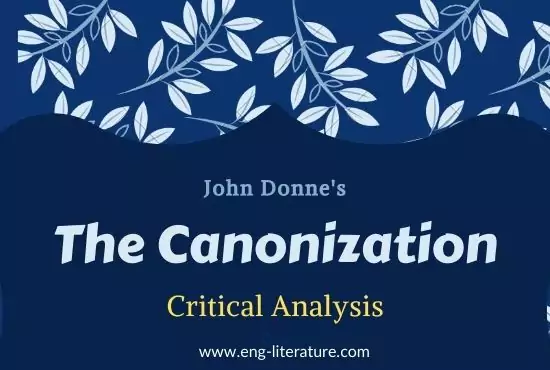The Canonization Analysis
With John Donne begins a new era in the history of English lyric poetry, of English satire and of English religious verse. He was the inspirer of his younger contemporaries and the first herald of the poetry of eloquence and argument. He was ‘the chief spokesman of the metaphysical poetry’. Defining metaphysical wit T.S. Eliot says, “It implies a constant inspection and criticism of experience. It involves probably a recognition implicit in the expression of every experience, of other kinds of experience which are possible”. Experience may be observed from different aspects: it may be viewed by the intellect or it may be felt by the emotions or it may be linked with man’s existence on earth. Donne’s treatment of his favourite theme, love, may be seen in this way.
The Canonization is a great love poem in which Donne celebrates his own love for his beloved, Ann More. It must have been written sometime in 1603 after the accession of James I. His marriage with Anne took place in 1601 in the face of strong opposition from her father and cousin, Sir Thomas Egerton, who dismissed Donne from his job. Thus he had to suffer a lot as a result of his love. That explains the note of irritation in the beginning of the poem. He warns people not to meddle in his love affair which is purely a personal matter. Let them busy themselves w other things like his physical infirmities, old age, misfortunes or the own activities of flattery and materialism.
He then laments the unwarranted rancour of people against his love. His love for his beloved is purely a personal affair which does not affect Cavane. It does no harm to others like sinking ships or flooding fields. Other people’s business activities and agricultural activities are not affected by his love. His love has not changed the climates nor caused diseases like the plague. People’s professions have not been affected, lawyers have their cases and soldiers their wars. So why should they oppose his love. In this section of the poem he hints at the absurdity of Petrarchan love where we have sigh tempests’ and ‘fear-floods’.
The lovers are confident and claim to be what they are because of their love for each other. They are identified with flies that fly round each other and with tapers that burn themselves out. The fly and the taper are conventional symbols of pining and sacrifice at the altar of love. They are the eagle and the dove. They are the phoenix bird. There is the masculinity of the eagle and the feminity or the meekness of the dove confined. The phoenix bird is single, both male and female and rises up young and vigorous from its own ashes. Thus the two lovers have become one through the mystery of love. This makes them worthy of canonization and they become saints.
This section, then, is a clear parody of the Christian practice of canonizing or declaring holy and pious people as saints, worthy of emulation. The two lovers are martyrs of love. They are ready to sacrifice their worldly life for the sake of love. This is the paradox of their life and death. Perhaps they will not be honoured with grand funeral ceremonies or vast tombs. But their legend of love will become the subject matter of poetry. These songs will be transformed into hymns in honour of saints. Thus their love has been spiritualised and they themselves have become saints, the patrons of true love. Thus the parody becomes complete.
The poem ends with the the parody on invoking saints as patrons or mediators. The lovers have become able to understand the quintessence of the world. They understand fully the microcosm of man and the macrocosm of the universe. They have thus become worthy of imitation and emulation. They are saints of love.
The poem cannot be dismissed merely as a parody of Christian sainthood. The emphasis is on the true love of the two lovers who are ready to face any consequences for the sake of love. There is sustained love and they have made hermitages of each other.
Also Read:
We notice in the poem an undercurrent of seriousness in spite of its outward light-heartedness and humour. There is an intermixture of thought and feeling and there is little scope for pure emotions. We also notice that the speech-rhythms correspond to the state of mind as revealed in the movement of the verse. The poem is an immortal one which perpetuates this legend of Donne’s love for his beloved Anne More.

Hello, Viewers! Besides being the Founder and Owner of this website, I am a Government Officer. As a hardcore literary lover, I am pursuing my dream by writing notes and articles related to Literature. Drop me a line anytime, whether it’s about any queries or demands or just to share your well-being. I’d love to hear from you. Thanks for stopping by!
